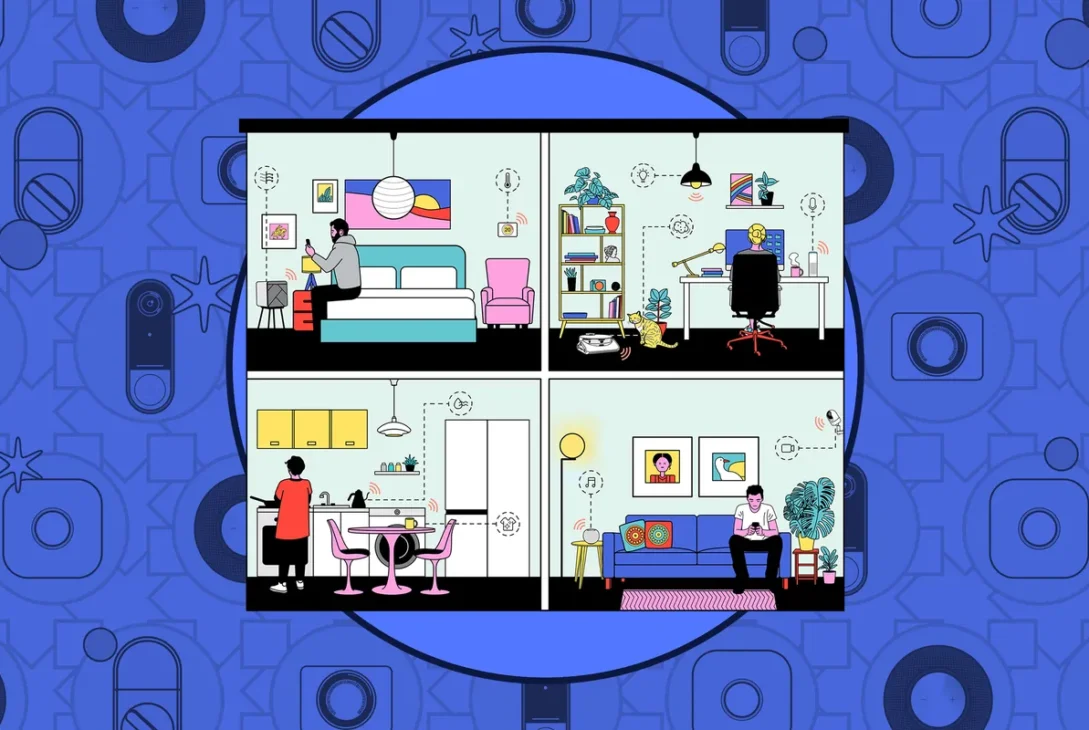As connectivity becomes standard for every home appliance, spanning from TVs and washing machines to ovens and vacuums, we’ll unravel the precise elements that define a ‘smart’ home and assist you in determining if it aligns with your needs.
Explaining the concept of a smart home in its simplest terms, it’s seen as a natural progression in the evolution of our residences. A smart home doesn’t represent a fundamental departure from a “regular” home; rather, it’s an enhancement of it. Much like how electricity transformed our homes, connectivity is now revolutionizing the way we inhabit and utilize our living spaces.
Having resided in a smart home for over a decade, my morning routine unfolds seamlessly. At 5 AM, the lights illuminate in my living area and kitchen, the automated pet feeder attends to my border terrier, and the security system disarms. As daylight emerges, the shades ascend, while the thermostat transitions from sleep to home mode, preparing the house for its occupants to rise. Upstairs, bedside lamps gradually brighten, mimicking natural light, leading up to the smart speakers gently sounding our alarms.
I dismiss my alarm with a simple tap, and my voice assistant promptly briefs me on the day’s schedule and provides a weather update to aid in outfit selection. Stepping into the bathroom triggers a motion sensor that activates the lights, and if the time is past 6 AM, the smart speaker initiates a 15-minute radio play as part of the routine.

As we head out for the morning school routine, the door securely locks behind us, the lights fade off, and the robot vacuum commences its cleaning duties. Upon my return about an hour later, the robot autonomously heads back to its dock, unloads itself, the door unlocks as I approach, and the lights illuminate the space.
By 8 AM, ascending the stairs to my home office triggers the smart thermostat to adjust while the downstairs lights dim. Activating a designated smart button in my office initiates a series of actions: the lighting shifts to emulate daylight, the ceiling fan starts whirring, my monitor powers up, an air purifier hums into action, and the smart speaker softly plays music, marking the start of my workday.
Each step in this morning ritual operates on automation. Through wireless protocols connecting appliances to each other and the internet, these actions are seamlessly controlled. Whether via an app on my phone or by voice commands to a smart speaker, adjustments can be made at any moment. This is the everyday experience of residing in a smart home.
What is a smart home?

Smart homes encompass a range of everyday household items in their “smart” iterations: from light bulbs, switches, and electrical outlets to thermostats, locks, doorbells, vacuums, and even appliances like refrigerators and washers. What distinguishes these devices as “smart” is their connectivity—either to the internet, other devices, or often both. This growing inclusion of chips in various appliances contributes to what’s termed the Internet of Things (IoT). While the methods of connectivity vary, the overarching connectivity enables three primary functionalities: remote control, inter-device communication, and the ability for over-the-air updates.
The connected nature of smart devices presents numerous advantages over their non-connected counterparts. For instance, a smart door lock can now be managed from a distance, allowing remote locking and unlocking. A smart sprinkler system can optimize watering schedules based on weather conditions, while a smart light switch not only controls lights manually but can also activate them automatically through motion sensors, even in different rooms.
Moreover, intelligence distinguishes smart devices from standard ones. Embedded sensors, software-driven artificial intelligence, and machine learning empower some smart devices to comprehend their surroundings and respond accordingly. For instance, a smart shade with temperature and light sensors can adjust based on changing environmental conditions. Similarly, a robot vacuum, using its camera and machine learning capabilities, can steer clear of unexpected obstacles, such as pet waste.
Inter-device communication is another key feature of smart technology. Sensors on windows can signal thermostats to deactivate when windows are open, an air purifier can trigger a fan to operate during periods of poor air quality, and motion sensors can command lights to switch off in unoccupied rooms. Additionally, multiple devices can be grouped into routines, allowing for automated adjustments throughout the home, much like the morning routine I described.
Furthermore, the capacity for over-the-air updates stands out as a significant advantage. Unlike traditional thermostats, smart thermostats can receive updates that enhance their capabilities post-purchase. For instance, a smart thermostat initially equipped with Amazon’s Alexa may receive updates enabling compatibility with Apple’s Siri.
However, there are risks to consider. The dependency on internet connectivity and software updates means that devices may cease functioning as intended if support is discontinued. Recent instances, such as Google’s termination of support for Nest Secure, highlight this issue. Regular security updates are essential, and while companies might provide timelines for supporting their hardware with software updates, the longevity of advanced functionalities isn’t guaranteed, potentially impacting the device’s original capabilities.

Here’s a look at some of the benefits a smart home might offer you:
A more secure dwelling: With connected home security systems, cameras, locks, and lights, you gain remote control and monitoring capabilities via your smartphone or tablet, ensuring constant vigilance over your home, no matter where you are. Smart lighting systems can be programmed on schedules to create the illusion of occupancy, while smart locks provide access to your home without the need for a physical key, preventing the necessity of hiding keys under flowerpots.
An enhanced energy-efficient residence: Individual smart devices like thermostats and sprinkler systems aid in resource conservation, cutting down on energy and water usage to save costs. Smart monitoring of energy consumption by appliances can recognize usage patterns, suggesting energy-saving strategies. The latest technologies, such as Samsung’s SmartThings Energy service, leverage artificial intelligence to adjust energy usage proactively based on collected data. For instance, it might increase the refrigerator temperature by a degree during hours when it’s typically not accessed, like 11 PM to 5 AM.
A more convenient household: Often, the initial smart device purchase resolves a specific inconvenience. Smart locks eliminate key reliance by permitting access via your phone or fingerprint. Meanwhile, mailbox contact sensors alert your phone or smart speaker when the mail arrives. Motorized blinds paired with smart speakers offer voice-controlled shade adjustments for inaccessible windows. Additionally, smart doorbells enable the silent mode feature when necessary, ensuring a quiet environment, especially when the baby is asleep.
A more enjoyable and comfortable living space: Beyond basic functionalities, smart LED lighting adds comfort and entertainment value. Color-changing LED lights elevate movie experiences and energize dance parties. Tunable white LEDs adjust light tones to sync with your circadian rhythm, energizing you during the day and aiding relaxation at night. Affordable smart speakers simplify multi-room audio setups, allowing synchronized music streaming throughout your home with multiple sub-$50 smart speakers.

A more assistive home: The integration of smart appliances like robot vacuums, intelligent fridges, washing machines, and ovens can alleviate household chores and optimize certain tasks. A smart refrigerator maintains inventory records and sends alerts when supplies run low, a smart washer communicates suitable settings to its dryer counterpart for the finished load, and a smart oven adjusts cooking times to prevent overcooking.
An inclusive dwelling: While these functions benefit all users, they can significantly enhance the lives of individuals with limited mobility. Voice-controlled or touchscreen-operated locks, lights, shades, and appliances enable increased independence for people with disabilities. Simultaneously, accessible interfaces like smart buttons, which trigger automated actions and routines, cater to children or individuals with cognitive or physical limitations. Programming routines to execute automatically within someone’s home can substantially ease their daily routines and contribute significantly to their quality of life.
Take, for instance, an automated setup designed for an elderly individual with restricted mobility living independently. The system can activate smart lighting in the morning, draw open the shades, enhance illumination throughout the day, and then softly dim the lights at night while closing the shades. Such a setup can make a substantial difference, offering a choice between spending the day in darkness or feeling more engaged with the outside world.
The inclusivity of smart home features transcends mere assistance for individuals facing greater challenges. It also serves as a strategic investment in the long-term functionality of a smart home. As we all age, the desire to remain in our own homes for as long as possible becomes more pronounced. Smart technology plays a pivotal role in enabling us to “age in place.” By integrating our homes with interconnected devices today, we set the stage for these technologies to support and care for us in the future.

At its essence, a smart home thrives on connectivity, requiring several components to function effectively:
- An internet connection.
- A Wi-Fi router (for larger homes or an extensive array of connected devices, consider a mesh router).
- Smart devices like light bulbs, locks, thermostats, speakers, and security cameras.
- A smart home app or platform for device setup and programming.
- A means of control, such as a smartphone, tablet, or voice-controlled smart speaker.
These smart home devices rely on diverse wireless protocols for connectivity. While there are numerous protocols in use, most smart home gadgets operate on one of these five:
- Z-Wave
- Zigbee
- Wi-Fi (2.4Ghz and 5Ghz)
- Bluetooth LE
- Thread
Certain protocols may require a hub or bridge to function, while others solely rely on a Wi-Fi router or smartphone. All these protocols are compatible with Matter, a newly introduced open standard that offers a common communication interface for devices, seen as a unifying force in the smart home. This implies that devices using different protocols (except Bluetooth, used solely for onboarding in Matter) have the potential to work with Matter, but the actual compatibility depends on the device manufacturer.
To utilize and configure smart devices, an app on a smartphone or tablet is necessary. Most devices come with their dedicated apps, yet as you expand your smart home setup, you may prefer a single smart home platform to centralize control. This enables the connection of devices from various manufacturers, creating routines and automations.
Five prominent platforms, all compatible with Matter, dominate the market. Additionally, there are smaller platforms catering to specific needs and complex setups. For more insights into choosing a smart home platform and in-depth explorations of these platforms, comprehensive guides are available, covering:
- Amazon Alexa
- Apple Home
- Google Home
- Samsung SmartThings
- Home Assistant
What are the limitations of a smart home system?
If you’ve made it this far, you might be thinking, “This is fantastic—where do I start?” But here’s the warning label. The smart home world is fraught with numerous issues, ranging from compatibility and complexity to privacy and security concerns. Even if these issues don’t faze you, one major setback is that the smart home system faces challenges when you attempt to expand it (unless you opt for a costly professional installation). Individually, devices work well, and gadgets from the same brand usually cooperate smoothly, but when you aim to integrate multiple devices into more intricate automations and routines—the ones that truly enhance your experience—problems can crop up.
Let’s explore the primary downsides of today’s smart home.
Compatibility conundrum: Not everything syncs seamlessly. Your smart lamp might sync beautifully with Apple Home and your iPhone but may not connect with your son’s Android phone. Different smart speaker brands within a household could prevent a unified multiroom music setup. And if your new smart lock operates on Z-Wave, it might require a smart home hub for control.
These are just a few instances illustrating why compatibility remains a headache. It leads to confusion, frustration, and the subsequent issue.
Complexity grows: Selecting compatible devices that work with your existing setup is challenging. Once you’ve picked a new gadget, setting it up can be a maze. Then comes the task of maximizing its features and connecting it to other devices to establish those automated functions that make a smart home truly smart.
Both these issues are precisely what Matter aims to address. This colossal industry collaboration involving Apple, Amazon, Samsung, Google, and more intends to resolve compatibility problems, simplifying the setup of smart home devices. However, while Matter shows promise, it’s still in its early stages, and widespread adoption is yet to happen.
Cost considerations: Integrating smart technology into everyday devices like light bulbs or door locks often hikes up their prices. Additionally, manufacturers are increasingly adding subscription fees to manage ongoing expenses for providing feature and security updates. While the benefits are undeniable—like remotely closing a garage door from your office—deciding whether to invest in a new smart garage door opener or a retrofit smart controller involves considering the added expense.
Reliability concerns: The smart home’s overdependence on the internet can be a downfall. If your Wi-Fi goes down and you can’t control your lights, it’s not a pleasant experience. There are also those weekends spent troubleshooting why your smart speaker suddenly can’t understand a command it previously executed without issue. When it all works, it’s like magic, but when it fails, it’s incredibly frustrating.
Security and privacy worries: Concerns about security and privacy within smart homes are substantial. Essentially, adopting a smart home necessitates trust. Even with advancements in edge-based machine learning, where devices process data without using the cloud, you’re still sharing intimate details of your life with companies whose devices are part of your home. Currently, this remains one of the most significant reasons to reconsider embracing the smart home in its current state.
What is the future of the smart home?

The current landscape of smart homes largely revolves around managing devices remotely and setting them up to operate automatically. You can use voice commands to turn off lights from bed or schedule a robot vacuum to clean floors daily at a specific time, relieving you of mundane tasks. However, the potential smart homes hold for tomorrow extends beyond mere reactivity; it might involve proactive actions performed without explicit commands—or perhaps even without our direct awareness.
This is where artificial intelligence (AI) could revolutionize the smart home. Hints of this potential exist today. Smart leak detectors can detect overflowing dishwashers and shut off the water. Intelligent thermostats adjust temperatures to conserve energy when nobody is home. Devices like Amazon’s Astro home robot can identify and locate individuals within the household. Yet, these experiences often rely on specific hardware and software setups. By leveraging predictive capabilities across unified smart home platforms, AI could analyze data from various devices to anticipate and act, streamlining the homeowner’s involvement.
For instance, current automation setups require manual configuration by the user—a series of actions triggered by an event, like unlocking doors and activating security cameras when a smoke alarm goes off. However, envision a future where a smart home autonomously executes these tasks only in genuine emergency situations, like a real fire, distinguishing it from scenarios like burnt toast.
To achieve this interoperable future, a standardized connectivity protocol is crucial, allowing all devices to communicate across different platforms. Here’s where Matter plays a pivotal role in shaping the future of smart homes. Equally essential is the accumulation of data.
The intelligence of a smart home hinges on the data it collects. Presently, motion and contact sensors provide information on movements and openings in our spaces. However, emerging technologies like mmWave radar, ultrasound, and Wi-Fi sensing offer less intrusive means of gathering contextual data, empowering smart devices to make informed decisions and transcend mere remote-controlled functionality.
Ultimately, akin to how our cars evolved, homes are on track to become sophisticated computing systems capable of self-diagnosing, addressing issues, and intelligently adapting to our preferences. It’s a natural progression. Even if the idea of a “smarter” home isn’t appealing, who wouldn’t want a more enhanced living space?










